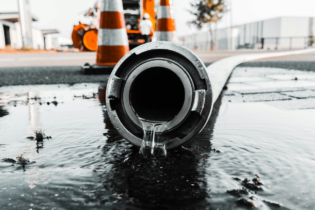Following the finalisation of the reliability test on 17 December last year, the Melbourne Desalination Plant has commenced with 27 years of operations in which it will be delivering drinking water into the Melbourne water system, finds Chantelle Mattheus.
Last yeara notable year for the plant, with a number of milestones being reached. June saw the first reverse osmosis water being produced and in August the plant commenced production of remineralised water. In September, not only did the plant enter into fullcapacity hydraulic testing, but it also completed a seven- day performance test in 100% automatic mode. The plant, which was constructed in Wonthaggi, 130 km south-east of Melbourne, is the largest desalination plant ever to be constructed in Australia and includes the construction of a 150 billion litre (expandable to 200 billion litres) reverse osmosis seawater desalination plant. “The Melbourne project takes the size of desalination plants to an entirely different level. The fact that it is structured as a bot (build, operate and transfer) project adds to the body of knowledge on the complexities of large-scale bot water projects,” says Degrémont South Africa’s deputy MD, Dumi Luthuli. He adds that there is no doubt that these technologies and efficiencies are exportable to other projects of a similar nature. Project breakdown Construction included a 1.1-km-long, 4 m diameter intake tunnel and a 1.4-km-long, 4 m diameter outlet tunnel, as well as an 84 km 1.9 m diameter reverse flow transfer pipeline and co-located power and fibreoptics, connecting the plant to Melbourne’s water, power and communications networks. Design and construction plans were developed with a commitment to minimising any adverse effects on the local landscape, cultural heritage and fauna and flora. The plant therefore occupies a very small footprint, taking up only 38 ha of the 263 ha site. The project is a public private partnership (PPP) to be undertaken by the AquaSure Consortium, comprising Degrémont SA, Suez Environment, Thiess Pty Ltd and Macquarie Group, in partnership with the Capital Projects division of the Australian Department of Sustainability and Environment. The AquaSure Consortium will therefore maintain and operate the plant until 2039.The Melbourne plant is an emblematic model for Degrémont Suez Environment, with the organisation set to operate the plant since operations have commenced officially for the next 27 years, supplying one third of Melbourne’s population with 450 000 m³/d of drinking water, produced from seawater.
Australia remains a strategic country for Degrémont as the group continues to expand its operations in the country in both waste management and water supply. They have also won contracts in Adelaide. According to reports from Degrémont at the end of last year, the majority of the work has been completed and several major technical challenges successfully resolved. The tunnels and marine facilities – namely the water intake and brine discharge – have been completed and are ready for operation, as well as the 84 km treated water main. The 87-km-long high-voltage power line and its substations have also been installed. At 87-km-long, the 220 000 volt (200 Kv HVAC) buried cable will appear to be the longest of this capacity in the world, with the line being especially constructed to power the desalination plant. Energisation of the plant is progressively undertaken until all the facilities and seawater desalination processes are brought into service. Concerning the reverse osmosis plant, the team is happy to report that the engineering work was completed on time with the equipment on-site and the first tests carried out successfully. “The start-up was carefully prepared, with the teams ready to move into action. Once again, we wish to emphasise the quality of the work done so far by our teams in the execution of this contract,” says Francine Dubreuil, Degrémont Marketing manager for Southern Africa. Local implications According to Luthuli, the likelihood of a plant of this size and stature being constructed locally cannot be ruled out.“At least one municipality and a water board are investigating large scale desalination plants for the next few years, although the sizes are likely to be much lower than the Melbourne plant. As to what the future holds, anything is possible,” he says. Should this become a reality, this could dramatically change the current water supply constraints in South Africa. “South Africa is classified as a water-stressed country. On the other hand, the country is blessed with a long coastline stretching more than 2 500 km. This is a valuable source of water that should be utilised to cover the present and future shortfalls,” advises Luthuli. The biggest lesson to be learnt from the success of the Melbourne plant though, according to Luthuli, is that with the right technologies, proper planning and minimisation of risks, knowledge of local conditions and proper management of resources, desalination projects of this size and complexity can be successfully executed.






